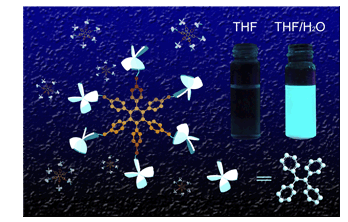| [1] (a) Maggini, L.; Bonifazi, D. Chem. Soc. Rev. 2012, 41, 211;
(b) Bonacchi, S.; Genovese, D.; Juris, R.; Montalti, M.; Prodi, L.; Rampazzo, E.; Zaccheroni, N. Angew. Chem., Int. Ed. 2011, 50, 4056;
(c) Wang, N.; Si, J.; Jin, Y.; Wang, J.; Huang, W. Acta Chim. Sinica 2015, 73, 171. (王娜娜, 司俊杰, 金一政, 王建浦, 黄维, 化学学报, 2015, 73, 171.);
(d) Wang, F.; Tao, Y.; Huang, W. Acta Chim. Sinica 2015, 73, 9. (王芳芳, 陶友田, 黄维, 化学学报, 2015, 73, 9.);
(e) Xu, G.; Li, J.; Chen, Z. Acta Chim. Sinica 2014, 72, 667. (徐广涛, 李佳, 陈忠宁, 化学学报, 2014, 72, 667.);
(f) Li, J.; Zeng, Y.; Zhang, X.; Yu, T.; Chen, J. P.; Li, Y. Acta Chim. Sinica 2014, 72, 1157. (李婧, 曾毅, 张小辉, 于天君, 陈金平, 李嫕, 化学学报, 2014, 72, 1157.)
[2] Jakubiak, R.; Collison, C. J.; Wan, W. C.; Rothberg, L. J.; Hsieh, B. R. J. Phys. Chem. A 1999, 103, 2394.
[3] (a) Mukherjee, S.; Thilagar, P. Dyes and Pigments 2014, 110, 2;
(b) Kalyani, N. T.; Dhoble, S. J. Renew. Sust. Energ. Rev. 2012, 16, 2696.
[4] Luo, J. D.; Xie, Z. L.; Lam, J. W. Y.; Cheng, L.; Chen, H. Y.; Qiu, C. F.; Kwok, H. S.; Zhan, X. W.; Liu, Y. Q.; Zhu, D. B.; Tang, B. Z. Chem. Commun. 2001, 18, 1740.
[5] (a) Chen, J.; Xie, Z.; Lam, J. W. Y.; Law, C. C. W.; Tang, B. Z. Macromolecules 2003, 36, 1108;
(b) Chen, J. W.; Law, C. C. W.; Lam, J. W. Y.; Dong, Y. P.; Lo, S. M. F.; Williams, I. D.; Zhu, D. B.; Tang, B. Z. Chem. Mater. 2003, 15, 1535.
[6] (a) Mei, J.; Hong, Y. N.; Lam, J. W. Y.; Qin, A. J.; Tang, Y. H.; Tang, B. Z. Adv. Mater. 2014, 26, 5429;
(b) Hu, R.; Leung, N. L. C.; Tang, B. Z. Chem. Soc. Rev. 2014, 43, 4494.
[7] Hong, Y. N.; Tong, H.; Dong, Y. Q.; Haeussler, M.; Lam, J. W. Y.; Tang, B. Z. Abstr. Pap. Am. Chem. S. 2006, 232.
[8] (a) Zhou, J.; Chang, Z. F.; Jiang, Y. B.; He, B. R.; Du, M.; Lu, P.; Hong, Y. N.; Kwok, H. S.; Qin, A. J.; Qiu, H. Y.; Zhao, Z. J.; Tang, B. Z. Chem. Commun. 2013, 49, 2491;
(b) Zhang, J. Y.; Yang, Q. T.; Zhu, Y. X.; Liu, H. L.; Chi, Z. G.; Su, C. Y. Dalton. Trans. 2014, 43, 15785;
(c) Wu, J.; Sun, S.; Feng, X. Q.; Shi, J. B.; Hu, X. Y.; Wang, L. Y. Chem. Commun. 2014, 50, 9122.
[9] (a) Huang, Y. Y.; Hu, F.; Zhao, R.; Zhang, G. X.; Yang, H.; Zhang, D. Q. Chem. Eur. J. 2014, 20, 158;
(b) Zhang, X. Q.; Liu, M. Y.; Yang, B.; Zhang, X. Y.; Chi, Z. G.; Liu, S. W.; Xu, J. R.; Wei, Y. Polym. Chem. 2013, 4, 5060.
[10] (a) Tong, H.; Hong, Y. N.; Dong, Y. Q.; Haeussler, M.; Li, Z.; Lam, J. W. Y.; Dong, Y. P.; Sung, H. H. Y.; Williams, I. D.; Tang, B. Z. J. Phys. Chem. B 2007, 111, 11817;
(b) Shustova, N. B.; Cozzolino, A. F.; Reineke, S.; Baldo, M.; Dinca, M. J. Am. Chem. Soc. 2013, 135, 13326;
(c) Dong, W. Y.; Fei, T.; Palma-Cando, A.; Scherf, U. Polym. Chem. 2014, 5, 4048;
(d) Zhao, G. S.; Shi, C. X.; Guo, Z. Q.; Zhu, W. H.; Zhu, S. Q. Chin. J. Org. Chem. 2012, 32, 1620. (赵国生, 史川兴, 郭志前, 朱为宏, 朱世琴, 有机化学, 2012, 32, 1620.)
[11] (a) Shih, P. I.; Chuang, C. Y.; Chien, C. H.; Diau, E. W. G.; Shu, C. F. Adv. Funct. Mater. 2007, 17, 3141;
(b) Luo, J. F.; Wang, X. H.; Wang, X. M.; Su, W. M.; Tao, X. T.; Chen, Z. G. Chin. J. Chem. 2012, 30, 2488.
[12] (a) Gust, D. J. Am. Chem. Soc. 1977, 99, 6980;
(b) Keegstra, M. A.; DeFeyter, S.; DeSchryver, F. C.; Mullen, K. Angew. Chem., Int. Ed. 1996, 35, 774.
[13] Chen, J. P.; Han, Y. B.; Li, Y. Imaging Science and Photochemistry 2014, 32, 484. (陈金平, 韩永滨, 李嫕, 影像科学与光化学, 2014, 32, 484.)
[14] (a) Hu, R. R.; Lam, J. W. Y.; Liu, Y.; Zhang, X.; Tang, B. Z. Chem. Eur. J. 2013, 19, 5617;
(b) Li, P.; Zeng, Y.; Chen, J. P.; Li, Y. Y.; Li, Y. Acta Chim. Sinica 2012, 70, 1611. (李鹏, 曾毅, 陈金平, 李迎迎, 李嫕, 化学学报, 2012, 70, 1611.)
[15] (a) Dong, Y. Q.; Lam, J. W. Y.; Qin, A. J.; Liu, J. Z.; Li, Z.; Tang, B. Z. Appl. Phys. Lett. 2007, 91, 011111;
(b) Tang, H. Y.; Zeng, Y.; Li, Y. Y.; Chen, J. P.; Li, Y. Acta Chim. Sinica 2011, 69, 2241. (唐海云, 曾毅, 李迎迎, 陈金平, 李嫕, 化学学报, 2011, 69, 2241.) |
